In this article, you’ll uncover the key differences between die grinders and angle grinders, two essential power tools used in various industries. Whether you’re a professional craftsman or a DIY enthusiast, understanding the nuances between these versatile tools will help you make informed decisions and choose the right one for your specific projects. From their design and functionality to the range of applications they excel in, we’ll explore the distinctive features of die grinders and angle grinders to ensure you have a clear understanding of their respective strengths and limitations.
Overview
Definition of Die Grinder
A die grinder is a handheld power tool often used in metalworking and fabrication. It is designed to perform various tasks such as grinding, polishing, honing, and sanding. The die grinder gets its name from the small, cylindrical shape of its grinding bit, known as a die. This versatile tool can be fitted with different types of dies and accessories to tackle a wide range of projects.
Definition of Angle Grinder
An angle grinder, also known as a disc grinder or a side grinder, is a powerful handheld tool used for cutting, grinding, and polishing. It features a rotating abrasive disc that is powered by a motor. The disc can be changed depending on the task at hand, making angle grinders suitable for various applications. This tool is commonly used in construction, metalworking, and woodworking.
Key Differences
While both die grinders and angle grinders serve similar purposes, there are some key differences that set them apart. Die grinders are typically smaller and more compact, making them ideal for intricate tasks or working in tight spaces. They operate at higher speeds and are often used with precision grinding bits for detail work. On the other hand, angle grinders are larger and more powerful, making them suitable for heavy-duty tasks like cutting through metal or removing rust and paint. They are also more commonly used with abrasive discs for surface preparation.
Die grinders are generally more precise and offer better control, while angle grinders provide more power and versatility. The choice between the two depends on the specific requirements of the project and the user’s preference.
Applications
Typical Uses of Die Grinder
Die grinders find extensive use in metalworking, woodworking, and automotive projects. Some common applications include:
- Deburring: Die grinders are excellent for removing sharp edges and burrs from metalwork.
- Polishing: With the right accessories, die grinders can be used for polishing and finishing surfaces.
- Grind and shape: Die grinders are ideal for precision grinding and shaping of various materials.
- Detail work: Their compact size and high speed make die grinders perfect for detailed work like engraving or chamfering.
- Weld cleaning: Die grinders can be used to clean welds and remove excess material for a clean, professional finish.
Typical Uses of Angle Grinder
Angle grinders are versatile tools with a wide range of applications. Some typical uses include:
- Cutting: Angle grinders excel at cutting through metal, tiles, concrete, and other tough materials.
- Grinding and shaping: They are used for grinding and shaping metal, stone, and other materials.
- Surface preparation: Angle grinders are commonly used for removing paint, rust, and corrosion, preparing surfaces for painting or welding.
- Masonry work: They are often used in masonry for tasks such as cutting bricks, tiles, or pavers.
- Woodworking: Angle grinders can be used for carving, shaping, and sanding wood.
Specialty Applications
Both die grinders and angle grinders have specialty applications:
- Die grinders, with their compact size and precise control, are used by jewelers, dentists, and other professionals for intricate tasks.
- Angle grinders, with their power and versatility, are commonly used in construction, metal fabrication, and automotive industries.
Although both tools can handle general tasks, their specific designs and features make them more suitable for certain applications.

Design and Size
Die Grinder Design
Die grinders typically have a streamlined design with a slender body and a small, cylindrical grinding bit known as a die. They are lightweight and easy to maneuver, allowing for precise control and access to tight spaces. Some die grinders have an ergonomic grip that provides comfort during prolonged use. The grinding bit can be easily changed to accommodate different tasks, making die grinders versatile and efficient.
Angle Grinder Design
Angle grinders have a bulkier design with a larger body and a rotating disc. They are available in different sizes, ranging from compact 4-inch models to powerful 9-inch models. The large disc size allows for faster material removal and increased cutting depth. Angle grinders feature a side handle for improved stability and control during operation. The disc can be easily changed to adapt to various tasks, making angle grinders flexible and adaptable.
Size Comparison
When it comes to size, die grinders are significantly smaller and lighter than angle grinders. This compact size makes die grinders the preferred choice for tasks that require precision and access to confined spaces. Angle grinders, on the other hand, are larger and more powerful, making them suitable for heavy-duty applications that require greater material removal and cutting capacity.
Power Source
Electric Die Grinders
Electric die grinders are powered by electricity and require a power outlet or a rechargeable battery to operate. They offer consistent and reliable power, making them suitable for extended use. Electric die grinders are available in various sizes and power ratings to meet different application requirements. They are generally more convenient to use than their pneumatic counterparts and do not require an air compressor.
Pneumatic Die Grinders
Pneumatic die grinders, also known as air grinders, are powered by compressed air. They require an air compressor to generate the necessary power. Pneumatic die grinders are commonly used in industrial settings where a constant supply of compressed air is available. They offer high torque and speed, making them ideal for heavy-duty applications. However, they require an air compressor and associated accessories, which can add to the overall cost and complexity.
Electric Angle Grinders
Electric angle grinders, like electric die grinders, are powered by electricity and require a power outlet or a rechargeable battery. They offer consistent and reliable power output, making them suitable for various applications. Electric angle grinders are available in different sizes and power ratings to accommodate different tasks and user preferences. They are typically more convenient to use than pneumatic angle grinders and do not require an air compressor.
Pneumatic Angle Grinders
Pneumatic angle grinders, also known as air angle grinders, are powered by compressed air. They require an air compressor to generate the necessary power. Pneumatic angle grinders are commonly used in industrial settings where a constant supply of compressed air is available. They offer high torque and speed, making them suitable for heavy-duty applications. However, they require an air compressor and associated accessories, which can add to the overall cost and complexity.

Speed and Control
Die Grinder Speed and Control
Die grinders are known for their high-speed rotation, typically ranging from 20,000 to 30,000 revolutions per minute (RPM). This high speed allows for efficient material removal and precise grinding. The compact size and lightweight design of die grinders provide excellent control and maneuverability, making them suitable for delicate and detailed work. The high RPM of die grinders makes them ideal for tasks that require precision and accuracy.
Angle Grinder Speed and Control
Angle grinders have variable speeds that can typically range from 5,000 to 11,000 RPM or even higher. This variable speed feature allows users to adjust the tool’s performance based on the task at hand. Angle grinders are powerful tools that can remove material quickly and efficiently. However, due to their larger size and higher power, they may not offer the same level of control and precision as die grinders. They are still versatile tools that provide satisfactory control for most applications.
Grinding Wheels and Discs
Die Grinder Wheels and Discs
Die grinders use a variety of wheels and discs to perform different tasks. Some common types of wheels and discs used with die grinders include ceramic, diamond, carbide, and abrasive wheels. These accessories are available in different shapes and sizes to accommodate different materials and applications. Die grinder wheels and discs are typically smaller in diameter, typically ranging from 1 to 2 inches, allowing for precise and detailed work.
Angle Grinder Wheels and Discs
Angle grinders are compatible with a wide range of wheels and discs. The most commonly used accessories with angle grinders are abrasive cutting discs, grinding wheels, and wire brushes. These accessories are available in various sizes and shapes to suit different materials and applications. Angle grinder wheels and discs are larger in diameter compared to die grinder accessories, typically ranging from 4 to 9 inches, allowing for faster material removal and greater cutting depth.
Compatibility
While some grinding wheels and discs can be used with both die grinders and angle grinders, it is important to note that certain accessories are specifically designed for one tool or the other. Die grinder accessories are typically smaller and may not fit on larger angle grinders, while angle grinder accessories may be too large or heavy for die grinders. It is essential to choose accessories that are compatible with the tool being used to ensure safe and efficient operation.

Safety Features
Die Grinder Safety Features
Die grinders, like all power tools, come with a range of safety features to protect the user:
- Safety Lock/Trigger: Die grinders often have a safety lock or trigger that prevents accidental operation when not in use.
- Ergonomic Grip: Some die grinders feature ergonomic handles that improve comfort and reduce hand fatigue during prolonged use.
- Safety Shields: Many die grinders have adjustable safety shields that provide protection against flying debris.
- Overload Protection: Some advanced die grinders have overload protection features that shut off the tool if it becomes overloaded or overheated.
- Exhaust Deflector: Die grinders may also have an exhaust deflector that redirects air away from the user, reducing the risk of debris getting into the eyes or face.
It is important to read and understand the user manual and follow all safety guidelines when operating a die grinder to minimize the risk of accidents or injuries.
Angle Grinder Safety Features
Angle grinders are equipped with various safety features to ensure safe operation:
- Safety Switch: Most angle grinders have a safety switch that prevents accidental start-up by requiring the user to press and hold a button while operating the tool.
- Adjustable Guard: Angle grinders feature an adjustable guard that provides protection against sparks, debris, and accidental contact with the disc.
- Anti-vibration Handle: Some angle grinders come with an anti-vibration handle that reduces hand fatigue and improves control during operation.
- Kickback Protection: Advanced angle grinders may have kickback protection features that help prevent the tool from suddenly jerking back if the disc gets stuck.
- Overload Protection: Some angle grinders have overload protection mechanisms that shut off the tool if it becomes overloaded or overheated.
It is essential to familiarize yourself with these safety features and use the tool in accordance with the manufacturer’s instructions to ensure safe operation.
Price Range
Die Grinder Price Range
Die grinders are available at various price points, depending on the brand, size, and features. Entry-level die grinders with basic functionality can be found for as low as $20, while high-end professional-grade die grinders with advanced features and accessories can cost upwards of $200. The price typically reflects the build quality, power rating, and additional features offered by the tool. It is important to find a balance between your budget and the specific requirements of your projects when choosing a die grinder.
Angle Grinder Price Range
Angle grinders are also available at different price points, depending on the brand, size, and features. Entry-level angle grinders suitable for DIYers and occasional use can be found for as low as $30, while professional-grade angle grinders with higher power and durability can cost over $300. Like die grinders, the price of an angle grinder is influenced by factors such as power rating, build quality, additional features, and accessories. It is important to consider your budget and the intended use of the tool when selecting an angle grinder.
Choosing the Right Grinder
Factors to Consider
When choosing between a die grinder and an angle grinder, several factors should be taken into consideration:
- Application: Consider the specific tasks and materials you will be working with. Die grinders are better suited for precision work and intricate tasks, while angle grinders are more versatile and suitable for heavy-duty applications.
- Size and Accessibility: Assess the workspace and determine whether a compact die grinder or a larger angle grinder would be more appropriate for the available space and maneuverability requirements.
- Power Source: Consider the availability of a power source, whether it be electricity or compressed air. Electric grinders offer convenience, while pneumatic grinders provide higher torque and speed for heavy-duty applications.
- Budget: Determine your budget and compare the prices of die grinders and angle grinders within your price range. Consider the value for money offered by the respective tools, taking into account their features, build quality, and brand reputation.
Personal Preference
Ultimately, the choice between a die grinder and an angle grinder may come down to personal preference. Some individuals may prefer the compact size and precise control of a die grinder, while others may appreciate the power and versatility of an angle grinder. It is recommended to try both tools, if possible, to determine which one feels more comfortable and suits your working style.
Expert Recommendations
Consulting with experts or professionals in the field can provide valuable insights and recommendations based on their experience. They can offer guidance on the most suitable tool for specific applications and provide recommendations based on their knowledge and expertise.
Maintenance
Die Grinder Maintenance
Proper maintenance is crucial to ensure the longevity and optimal performance of a die grinder:
- Follow the manufacturer’s instructions for regular maintenance, including cleaning, lubrication, and inspection.
- Regularly clean the grinding bits, removing any debris or buildup, to prevent damage or decreased performance.
- Check for any loose or damaged parts and replace or repair them as necessary.
- Keep the tool properly lubricated to prolong its lifespan and ensure smooth operation.
- Store the die grinder in a clean and dry environment, away from moisture or corrosive substances.
- Inspect the power cord regularly for any signs of damage, such as fraying or exposed wires, and replace if necessary.
By following these maintenance practices, you can maximize the lifespan and performance of your die grinder, ensuring it remains in optimal condition for years to come.
Angle Grinder Maintenance
To keep an angle grinder in top condition, regular maintenance should be performed:
- Follow the manufacturer’s guidelines for maintenance, including cleaning, lubrication, and inspection.
- Regularly inspect the disc for any signs of wear, damage, or uneven wear. Replace the disc if necessary.
- Clean the tool after each use to remove any debris or dust that may have accumulated.
- Check for any loose or damaged parts and replace or repair them as needed.
- Keep the tool properly lubricated to reduce friction and ensure smooth operation.
- Store the angle grinder in a clean and dry environment, away from moisture or corrosive substances.
By following these maintenance practices, you can prolong the life of your angle grinder and ensure its continued performance and safety.
In conclusion, both die grinders and angle grinders have their unique features and advantages. Die grinders are compact, precise, and suitable for intricate tasks, while angle grinders are larger, more powerful, and versatile. The choice between the two ultimately depends on the specific needs and preferences of the user. By considering factors such as application requirements, budget, and personal preferences, you can make an informed decision and choose the right grinder for your projects. Remember to always prioritize safety and follow the manufacturer’s instructions for safe and proper operation of the tool. With proper maintenance and care, both die grinders and angle grinders can be valuable additions to any workshop or toolbox.



